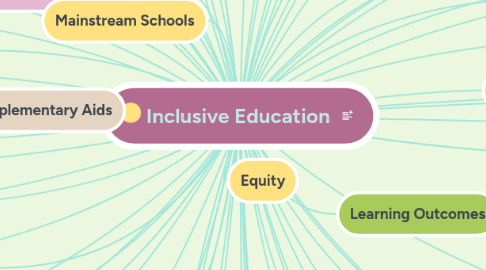Inclusive Education
by Naminder Sahota

1. Seamless integration
2. Behaviour Intervention
3. Learning Disability
4. Least Restrictive Environment
5. Speech/language Impairment
6. Parental Involvement
7. Supplementary Aids
8. Program Modifications
9. Mainstream Schools
10. Therapy
11. Counselling
11.1. Visual Aids
12. Writing Difficulties
13. Individualised Education Program
14. Discriminatory Attitudes
15. Flexible Assessments
16. Teaching Strategies
17. Teacher Training
18. Universal Design for Learning
19. Learner Engagement
20. Attainment
20.1. Support Services
21. Barrier Free Environment
22. Skills and Abilities
23. Discussions
24. Reports and Analytics
25. Observations and References
26. Road Maps
27. Capacity Building
28. Cohesive Societies
29. Crossing the Divide
30. Inclusive Pedagogy
31. Assess Equitably
32. Communication
33. Flexible Learning Environment
34. Equity
35. Respect
36. Alternative Subject Choice
37. Individual Needs
38. Differently Abled
39. Scaffolding
40. Diagnostic
41. Special Needs
42. Remediation
43. Developmental Delay
43.1. Feedback
44. Classroom Accomodations
45. Sensory Integration
46. Rehabilitation
47. Assistive Technology
48. Stimulation
49. Audio Aids
50. Life Skills
51. Peer Learning
52. Learning Outcome
53. School Health Services
54. Learning Outcomes
54.1. Support Organisations
55. Instructional Adaptations
56. Physical Inclusion
57. Academic Inclusion
58. Social Inclusion
58.1. Awareness
59. Pupil Needs
60. Inclusive School Practices
61. Paraprofessionals
62. Differentiation
63. Early Identification
64. Monitoring and Support
65. Curriculum Accessibility
66. Indicators
66.1. Immersion
67. Cohesive Societies
68. Co-Teaching
69. Beliefs
70. Support
71. Collaboration
72. Empowerment
73. Ability
74. Well Being
75. Individual Differences
76. Seamless Transition
77. Modified Textbooks
78. Resource Room
79. Challenges
80. Interventions


